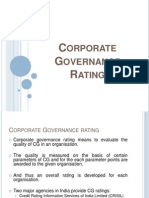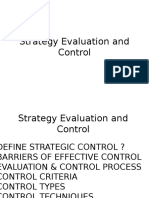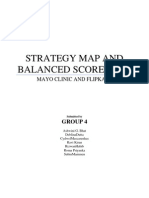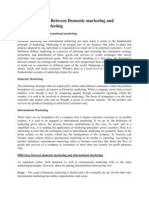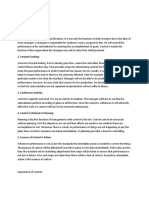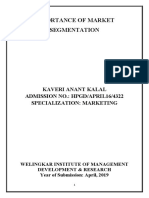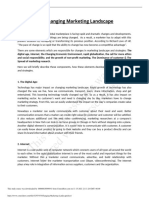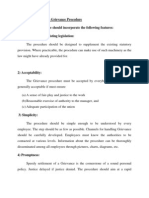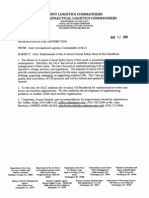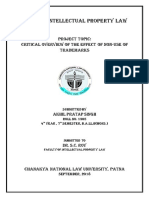Framework of International Marketing
Framework of International Marketing
Uploaded by
subbu2raj3372Copyright:
Available Formats
Framework of International Marketing
Framework of International Marketing
Uploaded by
subbu2raj3372Original Description:
Copyright
Available Formats
Share this document
Did you find this document useful?
Is this content inappropriate?
Copyright:
Available Formats
Framework of International Marketing
Framework of International Marketing
Uploaded by
subbu2raj3372Copyright:
Available Formats
1.
Framework of International Marketing DEFINITION OF INTERNATIONAL MARKETING: Kotler defines marketing as 'human activity directed at satisfying needs and wants through exchange process.' International marketing can be defined as "marketing carried on across national boundaries". International marketing has also been defined as ' the performance of business activities that direct the flow of goods and services to consumers or users in more than in one nation'. It is different from domestic marketing in as much as the exchange takes place beyond the frontiers, thereby involving different markets and consumers who might have different needs, wants and behavioral attributes. Scope of International Marketing: Though international marketing is in essence export marketing, it has a broader connotation in marketing literature. It also means entry into international markets by: Opening a branch/ subsidiary abroad for processing, packaging, assembly or even complete manufacturing through direct investment. Negotiating licensing/ franching arrangements whereby foreign enterprises are granted the right to use the exporting company's know-how's, viz., patents, processes or trademarks with or without financial investment. Establishing joint ventures in foreign countries for manufacturing and or marketing Offering consultancy services and undertaking turnkey projects broad. Depending upon the degree of firms involvement, there may be several variations of these arrangements. International Marketing vs. Domestic Marketing: There are a number of similarities and differences between international and domestic marketing. 1. Both in domestic marketing and international marketing success depend upon satisfying the basic requirements of consumers. This necessarily involves finding out what the buyers want and meeting their needs accordingly.
2. It is necessary to build goodwill both in the domestic market and international market. If a firm is able to develop goodwill of consumers or customers, its tasks will be simpler than the one, which has not been able to do so. 3. Research and development for product development and modification is necessary both for international marketing and domestic marketing. However, there are some salient features of difference between international marketing and domestic marketing. They are as follows: 1. Sovereign Political Entities: Each country has is a sovereign political entity and goods and services had to move across national boundaries. S a result, they may have to face a number of restrictions. This my all in any of the following categories; Tariffs and customs duties Quantitative restrictions Exchange controls Local Taxes. 2. Different Legal Systems: Each country has its own legal system and it differs from country to country. The existence of different legal systems makes the task of businessmen more difficult as they are not sure as to which particular system will apply to their transactions. In the case of domestic marketing the buyers are aware of the legal systems in their country. 3. Cultural Differences: In domestic marketing there is only one nation, same language and culture where as at international marketing many languages and different cultures. 4. Different Monetary Systems: Each country has its own monetary system and the exchange value of each country's currency is different from that of the other. The exchange rates between currencies fluctuate every day. In case of domestic marketing there is only one currency prevailing in the country. 5. Differences in the Marketing infrastructure: The availability of the marketing facilities available in different countries may vary widely. For example, an advertisement medium very effective in one market may not be available or may be under developed in another market. 6. Trade Restrictions: Trade restrictions, particularly import controls are a very important problem which an international marketer faces.
7. Transport Cost: In International trade, transport cost is a major marketing expense where as in domestic trade transport cost influences only to certain extent. 8. Procedures and Documentations: Each country has its own procedures and documentary requirements and traders have to comply with these regulations if they want to export or import goods from foreign countries. 9. Degree of Risk: There is a greater degree of risk involved in international marketing than in domestic marketing due to Large volume of transactions Higher value of transaction Longer time period More time of transit Longer credit period Comparatively less knowledge Exchange fluctuations.
10. Stability in Business Environment: In domestic marketing there is relatively stable business environment. At international marketing multiple environments, many of which are likely instable. TRANSITION FROM DOMESTIC TO INTERNATIONAL MARKET The Decision to enter foreign markets must be based on strong economic factors. Temperamental decision to export is transient in character and totally unsuitable for export marketing. Success in exporting requires total involvement and determination, which can come only out of basic economic necessity as perceived by the corporate unit. They grouped as Preexport behaviour and Motivation to Export. Pre-Export Behaviour: Every firm at some point of time starts as a non-exporter. The point to be studied is what made some of these firms get involved in export business. This must give a clue to the question as to whether a present non-exporter will become an exporter and if so why and
when. The factors, which influence a non-exporting firm's decision to go in for export business, can be classified under the following categories: (a) Firm characteristics: Firm characteristics include product characteristics; size and growth of the domestic market, optimum scale of production, and potential export markets. If the firm is manufacturing a product, which is internationally marketable, and the present and future market prospects in the domestic market are not much encouraging, the motivation of the firm to get involved in export business will be considerable. (b) Perceived External Export Stimuli: This will include fortuitous order, market opportunity and government's stimulation in the form of incentives and assistance. (c) Perceived Internal Export Stimuli: This refer to the management's expectations about the effects of exports on the firm's business. This covers the level of capacity utilization, the higher level of profits and the growth objectives of the firm. (d) Level of Organizational commitment: The decision makers must agree on the level of commitment. This is crucial because it will determine whether adequate resources will be made available for embarking on international marketing. Resources will be required for hiring new staff specialized in international marketing, hiring of consultants for carrying out overseas market potential studies etc., Motivation to Export: (Economic reasons) There are some basic economic reasons which might influence a firm decision regarding export business: These are under: Relative Profitability: The rate of profit to be earned from export business may be higher than the corresponding rate on the domestic sales. Insufficiency of Domestic Demand: The level of domestic demand may be insufficient for utilizing the installed capacity in full. Export business offers a suitable mechanism for utilizing the unused capacity. This will reduce costs and improve the overall profitability of the firm. Recession in the domestic market often serves as a stimulus to export ventures. Reducing business risks: When a firm is selling in a number of markets, the downward fluctuations in sales in one market, which may be the domestic market, may be fully or
partly counter balanced by a rise in the sales in other markets. Secondly, geographic diversification also provides the momentum to growth in as much as a single or few markets will have only limited absortive capacity. Legal restrictions: Governments may impose certain restrictions on further growth and capacity expansion of some firms within the domestic market in order to achieve certain social objectives. But there may not be any such restrictions, if the additional capacity is utilized for exports. Then the firm may be tempted to export its products abroad. Obtaining imported inputs: Nations have to pay for imports of materials, technology or processes not available within their national boundaries. Governments, therefore, may be compelled to impose export obligations on the firms, especially those in need of imported inputs. In other words, in order to import, the firms will have to export. Social responsibility: Sometimes businessmen themselves feel a sense of responsibility and contribute towards the national exchequer by increasing their exports. They also build up their image in domestic marketing by their export activities. They also look at exporting to attain status and prestige. Increased productivity: Increased productivity is necessary for ultimate survival of a firm. This will lead the firm to increase production and then move to export business. To meet the increased costs of Research and Development, larger markets become a necessity and exports become unavoidable. Technological improvement: Entry to export market may enable a firm to pick up new produce ideas and to add to product line, improve its product, reduce costs and discover new applications for its product.
You might also like
- Corporate Governance RatingDocument10 pagesCorporate Governance RatingMayur Devani75% (4)
- International Business EnvironmentDocument6 pagesInternational Business Environmentsubbu2raj3372No ratings yet
- Case Study of Strategic EvaluationDocument9 pagesCase Study of Strategic EvaluationFahad chowdhuryNo ratings yet
- Strategy and StructureDocument22 pagesStrategy and StructureLisaNo ratings yet
- The Independent Institute of Education 2016: Additional InstructionsDocument9 pagesThe Independent Institute of Education 2016: Additional InstructionsJared SedresNo ratings yet
- Indian Paint IndustryDocument5 pagesIndian Paint IndustryAbhinavSrivastavaNo ratings yet
- Retail PricingDocument64 pagesRetail PricingKalavathi KalyanaramanNo ratings yet
- B2B Product Decisions, New Product DevelopmentDocument30 pagesB2B Product Decisions, New Product DevelopmentRohan KadamNo ratings yet
- Product PortfolioDocument14 pagesProduct PortfolioRanjith KumarNo ratings yet
- Chapter 8 PricingDocument59 pagesChapter 8 PricingIman FirislamNo ratings yet
- Undifferentiated Marketing Differentiated Marketing Concentrated Targeting Customized MarketingDocument5 pagesUndifferentiated Marketing Differentiated Marketing Concentrated Targeting Customized MarketingTekletsadik TeketelNo ratings yet
- Strategic Brand ManagementDocument35 pagesStrategic Brand ManagementKrishna Chaitanya MadipalliNo ratings yet
- Strategy Evaluation and ControlDocument39 pagesStrategy Evaluation and ControlTansen John100% (1)
- BSC & Strat MapDocument10 pagesBSC & Strat MapSharon Elin SunnyNo ratings yet
- Opinion LeadershipDocument7 pagesOpinion LeadershipAnand SinghNo ratings yet
- Module # 2 Pricing StrategiesDocument13 pagesModule # 2 Pricing StrategiesgraceNo ratings yet
- Government Influence On Trade and InvestmentDocument11 pagesGovernment Influence On Trade and InvestmentKrunal Maniyar100% (2)
- The Internal Assessment: Strategic Management: Concepts & Cases 13 Edition Global Edition Fred DavidDocument84 pagesThe Internal Assessment: Strategic Management: Concepts & Cases 13 Edition Global Edition Fred DavidKhaled WaelNo ratings yet
- Unit-V Marketing Organization and ControlDocument6 pagesUnit-V Marketing Organization and ControlVipin KushwahaNo ratings yet
- CB AuditDocument28 pagesCB AuditPavan Kuchar100% (2)
- 4.3 Difference Between Domestic Marketing and International MarketingDocument2 pages4.3 Difference Between Domestic Marketing and International MarketingTariq Ul KarimNo ratings yet
- GROWING AND SUSTAINING BRAND EQUITY-Unit 5Document21 pagesGROWING AND SUSTAINING BRAND EQUITY-Unit 5Meenu Mathur100% (1)
- Promotion and Communication of ServicesDocument25 pagesPromotion and Communication of ServicesArpan ChaudharyNo ratings yet
- Characteristics of ControlDocument4 pagesCharacteristics of Controlrosa4rosata1No ratings yet
- Dagmar ApproachDocument24 pagesDagmar ApproachTaimoor MazharNo ratings yet
- Approaches To MarketingDocument9 pagesApproaches To MarketingSubhasish MitraNo ratings yet
- Chapter 14 Market DevelopmentDocument29 pagesChapter 14 Market DevelopmentMong TityaNo ratings yet
- Strategic Brand Management by KellerDocument1 pageStrategic Brand Management by Kellerhcyrus007No ratings yet
- Corporate Portfolio AnalysisDocument8 pagesCorporate Portfolio AnalysisSneha Mulchandani100% (1)
- The Core Concept of MarketingDocument19 pagesThe Core Concept of Marketingankushdeshmukh86% (7)
- Strategies For Reducing Customers DefectionDocument3 pagesStrategies For Reducing Customers Defectiondeepika tolwani100% (1)
- The Nature of Strategy EvaluationDocument9 pagesThe Nature of Strategy Evaluationyosef bekeleNo ratings yet
- Ethical Issues in Marketing ResearchDocument9 pagesEthical Issues in Marketing Researchimad86% (7)
- Generic StrategiesDocument37 pagesGeneric StrategiesSneha Karpe100% (1)
- Malhotra MR6e 01Document28 pagesMalhotra MR6e 01Tabish BhatNo ratings yet
- 374 33 Powerpoint-Slides 4-Sales-Force-management Chapter 4 Sales Force ManagementDocument20 pages374 33 Powerpoint-Slides 4-Sales-Force-management Chapter 4 Sales Force ManagementBharatha Herath100% (1)
- Measuring Effectiveness of The Promotional ProgramDocument14 pagesMeasuring Effectiveness of The Promotional ProgramJazmin Andoy100% (2)
- Channel ConflictDocument15 pagesChannel ConflictNupur Saurabh AroraNo ratings yet
- Marketing Information SystemDocument36 pagesMarketing Information SystemMalik MohamedNo ratings yet
- Importance of Market Segmentation - KaveriDocument63 pagesImportance of Market Segmentation - KaveriSAJIDA SHAIKH100% (1)
- Concept of Strategy, Concept of Strategic Management and TypeDocument18 pagesConcept of Strategy, Concept of Strategic Management and Typepopat vishal100% (1)
- Scope of Marketing Management 1Document9 pagesScope of Marketing Management 1hysbeslem02No ratings yet
- Unit-1 Product Management - Basic ConceptsDocument9 pagesUnit-1 Product Management - Basic Conceptsbhar4tpNo ratings yet
- Marketing EnvironmentDocument33 pagesMarketing EnvironmentPRADEEP CHAVANNo ratings yet
- Chapter 5 Industrial Product DecisionsDocument11 pagesChapter 5 Industrial Product DecisionsMiesa MelkamuNo ratings yet
- Launching A New VentureDocument4 pagesLaunching A New VenturesoorajNo ratings yet
- Strategy - Porter's Generic StrategiesDocument35 pagesStrategy - Porter's Generic StrategiesAtakelt HailuNo ratings yet
- S3 Corporate Level StrategiesDocument15 pagesS3 Corporate Level Strategiespravit08No ratings yet
- Chapter 5 Segmentation, Targeting and Positioning StrategiesDocument35 pagesChapter 5 Segmentation, Targeting and Positioning StrategiesShreeshabNo ratings yet
- 3P - Finance With Other DisciplinesDocument2 pages3P - Finance With Other DisciplinesRaju RajendranNo ratings yet
- Unit 4 Dividend DecisionsDocument17 pagesUnit 4 Dividend Decisionsrahul ramNo ratings yet
- This Study Resource Was: The Changing Marketing LandscapeDocument4 pagesThis Study Resource Was: The Changing Marketing Landscapeánh Trần100% (2)
- Portfolio RevisionDocument28 pagesPortfolio RevisionRaj YadavNo ratings yet
- Focus StrategyDocument14 pagesFocus Strategysai praneethNo ratings yet
- Market Potential and Sales ForecastingDocument30 pagesMarket Potential and Sales ForecastingraamseNo ratings yet
- Ethics in RetailingDocument16 pagesEthics in RetailingRenjul Paravur100% (2)
- Marketing Research ProcessDocument22 pagesMarketing Research ProcessJasjot BindraNo ratings yet
- MM NotesDocument79 pagesMM NotesDarshan NallodeNo ratings yet
- Product and Brand StrategyDocument18 pagesProduct and Brand Strategyoureducation.inNo ratings yet
- International MarketingDocument19 pagesInternational Marketinggirijadtt3No ratings yet
- International TradeDocument103 pagesInternational Tradevinothkumararaja824975% (4)
- International Marketing DefinedDocument8 pagesInternational Marketing DefinedPrithwish KotianNo ratings yet
- International Marketing 1Document11 pagesInternational Marketing 1Irfana Mubarak100% (1)
- Sbaa 5301Document143 pagesSbaa 5301samayasanjeeviNo ratings yet
- Business Case Study 4Document1 pageBusiness Case Study 4subbu2raj3372No ratings yet
- E Tourism LectureDocument24 pagesE Tourism Lecturesubbu2raj3372No ratings yet
- Consumer Behavior On AutomobilesDocument24 pagesConsumer Behavior On Automobilessubbu2raj3372No ratings yet
- Typologies of E-TourismDocument18 pagesTypologies of E-Tourismsubbu2raj3372No ratings yet
- Procedure Before SearchDocument1 pageProcedure Before Searchsubbu2raj3372No ratings yet
- Research MethodologyDocument34 pagesResearch Methodologysubbu2raj3372No ratings yet
- Business Case 3Document1 pageBusiness Case 3subbu2raj3372No ratings yet
- Unmarried Mothe1Document3 pagesUnmarried Mothe1subbu2raj3372No ratings yet
- National IncomeDocument4 pagesNational Incomesubbu2raj3372No ratings yet
- Part One: Learning ObjectivesDocument12 pagesPart One: Learning ObjectivesgeombajobsNo ratings yet
- TransportDocument31 pagesTransportsubbu2raj3372No ratings yet
- Brand Management AssignmentDocument10 pagesBrand Management Assignmentsubbu2raj3372No ratings yet
- Logistics IndustryDocument48 pagesLogistics IndustryTanu NigamNo ratings yet
- Service Quality LiteratureDocument10 pagesService Quality Literaturesubbu2raj3372100% (1)
- Chickenpox Chickenpox Is A Highly Contagious Disease Caused by Primary Infection With Varicella ZosterDocument12 pagesChickenpox Chickenpox Is A Highly Contagious Disease Caused by Primary Infection With Varicella Zostersubbu2raj3372100% (2)
- Account ReceivablesDocument5 pagesAccount Receivablessubbu2raj3372No ratings yet
- Mcdonald Vs KFCDocument17 pagesMcdonald Vs KFCsubbu2raj3372100% (1)
- Industrial SafetyDocument5 pagesIndustrial Safetysubbu2raj3372100% (1)
- Logistics IndustryDocument8 pagesLogistics Industrysubbu2raj3372No ratings yet
- Literature Review On CRMDocument4 pagesLiterature Review On CRMsubbu2raj3372100% (1)
- Questionnaire On Changing Importance of Media Vehicle in Advertising1Document6 pagesQuestionnaire On Changing Importance of Media Vehicle in Advertising1subbu2raj3372No ratings yet
- Accounts Receivable ManagementDocument7 pagesAccounts Receivable Managementsubbu2raj3372No ratings yet
- Accounts Receivable ManagementDocument4 pagesAccounts Receivable Managementsubbu2raj3372No ratings yet
- Desirable Features of A Grievance ProcedureDocument4 pagesDesirable Features of A Grievance Proceduresubbu2raj3372100% (2)
- Probablity QuestionsDocument14 pagesProbablity QuestionsSetu Ahuja100% (1)
- Main FileDocument65 pagesMain FileKomal MansukhaniNo ratings yet
- Discover Your Prime Value Chain Align JournalDocument5 pagesDiscover Your Prime Value Chain Align JournalWilson Perumal & CompanyNo ratings yet
- Nationalization and Privatization of Commercial BanksDocument24 pagesNationalization and Privatization of Commercial BanksAli JumaniNo ratings yet
- Nano-Tera 2016 State of The ArtDocument71 pagesNano-Tera 2016 State of The ArtnanoteraCHNo ratings yet
- FVCLU V SANAMA-SIGLODocument3 pagesFVCLU V SANAMA-SIGLOJenny Mary Dagun100% (2)
- Aviation CSIHandbookDocument186 pagesAviation CSIHandbookxclublifestyleNo ratings yet
- 2017 SalnDocument3 pages2017 SalnDracoVolansNo ratings yet
- Iag Narrative ReportDocument16 pagesIag Narrative ReportHoely SaintNo ratings yet
- Difference Between Positive and Normative EconomicsDocument21 pagesDifference Between Positive and Normative EconomicsKevin Fernandez MendioroNo ratings yet
- Practical Accounting Training Work FileDocument9 pagesPractical Accounting Training Work Filelikhith.thomasNo ratings yet
- Method of Data CollectionDocument2 pagesMethod of Data CollectionZainabJitpurwalaNo ratings yet
- Heritage and Creative Enterprise: Ananya BhattacharyaDocument6 pagesHeritage and Creative Enterprise: Ananya Bhattacharyadineshjain11No ratings yet
- Brand Relationship SpectrumDocument21 pagesBrand Relationship SpectrumRavi Ninne100% (1)
- Bryan Resume 2019Document2 pagesBryan Resume 2019Bryan GoodwinNo ratings yet
- Assembly Line BalancingDocument46 pagesAssembly Line Balancingshewalepp100% (1)
- SUBJECT: Intellectual Property Law: Project Topic: Critical Overview of The Effect of Non-Use of TrademarksDocument24 pagesSUBJECT: Intellectual Property Law: Project Topic: Critical Overview of The Effect of Non-Use of TrademarksRishabh Goswami100% (1)
- Sugarlicious International MarketingDocument16 pagesSugarlicious International MarketingAnoushka SequeiraNo ratings yet
- A Study To Determine The Home-Buyer's Preferences Through Voice of CustomerDocument7 pagesA Study To Determine The Home-Buyer's Preferences Through Voice of CustomerIOSRJEN : hard copy, certificates, Call for Papers 2013, publishing of journalNo ratings yet
- CV - Vasco Vicente de Freitas - EngDocument2 pagesCV - Vasco Vicente de Freitas - EngVasco Vicente de FreitasNo ratings yet
- Maintenance Agreement ContractDocument4 pagesMaintenance Agreement Contractgigi556No ratings yet
- Evaluation Criteria: Richter (Leeb) Hardness GaugeDocument1 pageEvaluation Criteria: Richter (Leeb) Hardness GaugeTaha MirzaNo ratings yet
- Lbata 1990 Amendment Up To 2011 PDFDocument28 pagesLbata 1990 Amendment Up To 2011 PDFsyahiraNo ratings yet
- Popular Mechanics - August 2023 USADocument84 pagesPopular Mechanics - August 2023 USARob JongenNo ratings yet
- Asian Journal of Empirical Research: Umair CheemaDocument10 pagesAsian Journal of Empirical Research: Umair CheemaGlenda Mae GemalNo ratings yet
- BCR-0-744-2022 - SM Store Installment Offer For Year 2023Document3 pagesBCR-0-744-2022 - SM Store Installment Offer For Year 2023Vivienne MarchelineNo ratings yet
